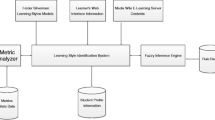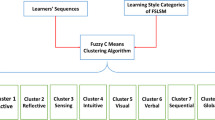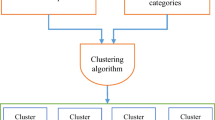Abstract
The performance of the learners in E-learning environments is greatly influenced by the nature of the posted E-learning contents. In such a scenario, the performance of the learners can be enhanced by posting the suitable E-learning contents to the learners based on their learning styles. Hence, it is very essential to have a clear knowledge about various learning styles in order to predict the learning styles of different learners in E-learning environments. However, predicting the learning styles needs complete knowledge about the learners past and present characteristics. Since the knowledge available about learners is uncertain, it can be resolved through the use of Fuzzy rules which can handle uncertainty effectively. The core objective of this survey paper is to outline the working of the existing learning style models and the metrics used to evaluate them. Based on the available models, this paper identifies Felder–Silverman learning style model as the suitable model for E-learning and suggests the use of Fuzzy rules to handle uncertainty in learning style prediction so that it can enhance the performance of the E-learning system.
Similar content being viewed by others
References
Anozie N, Junker BW (2006) Predicting end-of-year accountability assessment scores from monthly student records in an online tutoring system. In: Proceedings of AAAI workshop on educational data mining, Menlo Park, pp 1–6
Antunes C (2008) Acquiring background knowledge for intelligent tutoring systems. In: Proceedings of international conference on educational data mining, Montreal, pp 18–27
Avouris N, Komis V, Fiotakis G, Margaritis M, Voyiatzaki E (2005) Why logging of fingertip actions is not enough for analysis of learning activities. In: Proceedings of AIED conference on workshop usage analysis learning system, Amsterdam, pp 1–8
Ayers E, Nugent R, Dean N (2009) A comparison of student skill knowledge estimates. In: Proceedings of international conference on educational data mining, Cordoba, pp 1–10
Baker R, Corbett A, Koedinger K (2004) Detecting student misuse of intelligent tutoring systems. In: Proceedings of international conference on intelligence tutoring system, Alagoas, pp 531–540
Baker R, Corbett AT, Aleven V (2008) Improving contextual models of guessing and slipping with a truncated training set. In: Proceedings of international conference on educational data mining, Montreal, pp 67–76
Ba-Omar H, Petrounias I, Anwar F (2007) A framework for using web usage mining for personalise E-learning. In: Proceedings of international conference on advanced learning technologies, Niigata, pp 937–938
Bari M, Lavoie B (2007) Predicting interactive properties by mining educational multimedia presentations. In: Proceedings of international conference on information and communication technology, pp 231–234
Barnes T (2005) The q-matrix method: mining student response data for knowledge. In: Proceedings of AAAI workshop educational data mining, Pittsburgh, pp 1–8
Beck JE, Baker R, Corbett AT, Kay J, Litman DJ, Mitrovic T, Ritter S (2004) Presented at the 7th international conference on workshop analyzing student tutor interaction logs improve educational outcomes, Alagoas
Bergasa-Suso J, Sanders DA, Tewkesbury GE (2005) Intelligent browser-based systems to assist Internet users. IEEE Trans Educ 48(4): 580–585
Boyatzis RE, Kolb DA (1997) Assessing individuality in learning: the learning skills profile. Educ Psychol 11(3–4): 279–295
Brokaw AJ, Merz TE (2000) The effects of student behavior and preferred learning style on performance. J Bus Educ 1: 44–53
Burr L, Spennemann DH (2004) Pattern of user behavior in university online forums. Int J Instr Technol Distance Learn 1(10): 11–28
Butler K (1986) A learning and teaching style in theory and practice. Learner’s Dimension, Columbia
Carver CA, Howard RA, Lane WD (1999) Enhancing student learning through hypermedia courseware and incorporation of student learning styles. IEEE Trans Educ 42(1): 33–38
Chen S-M, Chang Y-C (2011) Weighted fuzzy rule interpolation based on GA-based weight-learning techniques. IEEE Trans Fuzzy Syst 19(4): 729–744
Chen Y, Weng C (2009) Mining fuzzy association rules from questionnaire data. Knowl Based Syst J 22(1): 46–56
Chen G, Liu C, Ou K, Liu B (2000) Discovering decision knowledge from web log portfolio for managing classroom processes by applying decision tree and data cube technology. J Educ Comput Res 23(3): 305–332
Chen C, Duh L, Liu C (2004) A personalized courseware recommendation system based on fuzzy item response theory. In: Proceedings of IEEE international conference on E-Technology, E-Commerce E-Service, Washington, pp 305–308
Chen CH, Hong CM, Chang CC (2008) Mining interactive social network for recommending appropriate learning partners in aWeb-based cooperative learning environment. In: Proceedings of IEEE conference on Cybernetics, intelligence systems, Chengdu, pp 642–647
Chu HC, Hwang GJ, Tseng JCR, Hwang GH (2006) A computerized approach to diagnosing student learning problems in health education. Asian J Health Inf Sci 1(1): 43–60
Claxton CS, Murrell PH (1987) Learning styles. George Washington University (ERIC), Washington
Coffield FJ, Moseley DV, Hall E, Ecclestone K (2004) Learning styles and pedagogy in post-16 learning: a systematic and critical review. Learning and Skills Research Centre, London
Cornwell JM, Manfredo PA (1994) Kolb learning style theory revisited. Educ Psychol Meas 54(2): 317–327
Costa PT, McCrae RR (1992) NEO PI-R. Professional manual. Psychological Assessment, Odessa, FL
Crespo RM, Pardo A, P’erez JP, Kloos CD (2005) An algorithm for peer review matching using student profiles based on fuzzy classification and genetic algorithms. In: Proceedings of international conference on innovations in applied artificial intelligence, Bari, pp 685–694
Dekker GW, Pechenizkiy M, Vleeshouwers JM (2009) Predicting students drop out: a case study. In: Proceedings of international conference on educational data mining, Cordoba, pp 41–50
Dringus LP, Ellis T (2005) Using data mining as a strategy for assessing asynchronous discussion forums. Comput Educ J 45(1): 141–160
Duff A (2002) Approaches to learning: factor variance across gender. Person Individ Differ 33(6): 997–1110
Dunn R (1990) Understanding the Dunn and Dunn learning style model and the need for individual diagnosis and prescription. Read Writ Learn Disabil 6: 223–247
Dunn R., Dunn K (1989) Learning style inventory. Price Systems, Lawrence
Felder RM, Silverman LK (1988) Learning styles and teaching styles in engineering education. Eng Educ 78(7): 674–681
Fleming ND (2001) Teaching and learning styles: VARK strategies. N.D. Fleming, Christchurch
Garcia E, Romero C, Ventura S, Castro C (2009) An architecture for making recommendations to courseware authors using association rule mining and collaborative filtering. User Model. User-Adapted Interaction. J Person Res 19: 99–132
Gardner H (1999) Intelligence reframed: multiple intelligences for the 21st century. Basic Books, New York
Gardner H (2004) Changing minds: the art and science of changing our own and other people’s minds. Harvard Business School Press, Boston, p 196
Gardner H, Moran S (2006) The science of multiple intelligences theory: a response to Lynn Waterhouse. Educ Psychol 41(4): 227–232
Gilbert JE, Han CY (1999) Adapting instruction in search of a significant difference. J Netw Comput Appl 22(3): 149–160
Gregorc AF. (1985) Inside styles: beyond the basics. Gabriel sys, Maynard
Gregorc AF, Ward H (1977) BA new definition for individual: implications for learning and teaching. NASSP Bull 401(6): 20–23
Hawk TF, Shah AJ (2007) Using learning style instruments to enhance student learning. Decis Sci J Innov Educ 5(1): 1–19
Hubscher R, Puntambekar S, Nye A (2007) Domain specific interactive data mining. In: Proceedings of 11th international conference on user model. Workshop on data mining user model, Corfu, pp 81–90
Hwang WY, Chang CB, Chen GJ (2004) The relationship of learning traits, motivation and performance learning response dynamics. Comput Educ J 42: 267–287
Honey P, Mumford A (2000) The learning styles helper’s guide. Peter Honey Publications Ltd, Maidenhead
Jackson C (2002) Manual of the learning styles profiler. Available at http://www.cymeon.com
Jegatha Deborah L, Baskaran R, Kannan A (2011a) Construction of ontology using computational linguistics for E-learning: In: Proceedings of the 2nd international conference on visual informatics, Kualalumpur. Springer—Lecture Notes in Computer Science, pp 50–63
Jegatha Deborah L, Karthika V, Baskaran R, Kannan A (2011b) Deontic based ontology matching for conflict resolution between text documents: In: Proceedings of the international conference on information processing, Bangalore. Springer—Communications in Computer and Information Science, pp 526–535
Jonassen DH, Grabowski BL (1993) Handbook of individual difference, learning, and instruction. Lawrence Erlbaum Associates, Publishers, Hillsdale NJ
Kim J, Chern G, Feng D, Shaw E, Hovy E (2006) Mining and assessing discussions on the web through speech act analysis. In: Proceedings of AAAI workshop web content mining human language technology, Athens, pp 1–8
Kolb D (1984) Experiential learning: experience as the source of learning and development. Prentice-Hall, Englewood Cliffs
Kolb AY, Kolb DA (2005) Learning styles and learning spaces: enhancing Experiential learning in higher education. Acad Manag Learn Educ 4(2): 193–212
Lau R, Chung A, Song D, Huang Q (2007) Towards fuzzy domain ontology based concept map generation for E-learning. In: Proceedings of international conference on web-based learning, Edinburgh, pp 90–101
Lu J (2004) A personalized E-learning material recommender system. In: Proceedings of international conference on information technology application, Harbin, pp 374–379
Lu F, Li X, Liu Q, Yang Z, Tan G, He T (2007) Research on personalized E-learning system using fuzzy set based clustering algorithm. In: Proceedings of international conference on computer science, Beijing, pp 587–590
Martinez D (2001) Predicting student outcomes using discriminant function analysis. In: Proceedings of Meeting Research Planning Group, Lake Arrowhead, pp 1–22
McCaulley MH (2000) Myers–Briggs type indicator: a bridge between counseling and consulting. Consult Psychol J Practice Res 52: 117–132
McDonald B (2004) Predicting student success. J Math Teach Learn 1: 1–14
Minaei-bidgoli B, Tan P, Punch W (2004) Mining interesting contrast rules for a web-based educational system. In: Proceedings of international conference on machine learning applications, Los Angeles, pp 1–8
Myller N, Suhonen J, Sutinen E (2002) Using data mining for improving web-based course design. In: Proceedings of international conference on computing education, Washington, pp 959–964
Nebot A, Castro F, Vellido A, Mugica F (2006) Identification of fuzzy models to predict students performance in an E-learning environment. In: Proceedings of international conference on web-based education, Puerto Vallarta, pp 74–79
Nesbit JC, Xu Y, Winne PH, Zhou M (2008) Sequential pattern analysis software for educational event data. In: Proceedings of international conference on methods technology. Behav. Res. Netherlands
Nugent R, Ayers E, Dean N (2009) Conditional subspace clustering of skill mastery: identifying skills that separate students. In: Proceedings of international conference on educational data mining, Cordoba, pp 101–110
Oladokun VO, Adebanjo AT, Charles-Owaba OE (2008) Predicting student’s academic performance using artificial neural network: a case study of an engineering course. Proc Pac J Sci Technol 9(1): 72–79
Papanikolaou KA, Grigoriadou M, Magoulas GD, Kornilakis H (2002) Towards new forms of knowledge communication: the adaptive dimensions of a web-based learning environment. Comput Educ 39(4): 333–360
Pardos Z, Beck JE, Ruiz C, Heffernan N (2008) The composition effect: conjunctive or Compensatory? An analysis of multi-skill math questions in ITS. In: Proceedings of international conference on educational data mining, Montreal, pp 147–156
Pittenger DJ (2005) Cautionary comments regarding the Myers–Briggs type indicator. Consult Psychol J Practice Res 57(3): 210–221
Robinet V, Bisson G, Gordon M, Lemaire B (2007) Searching for student intermediate mental steps. In: Proceedings of international conference on user model. Workshop data mining user modelling, Corfu, pp 101–105
Rus V, Lintean M, Azevedo R (2009) Automatic detection of student mental models during prior knowledge activation in MetaTutor. In: Proceedings of international conference on educational data mining, Cordoba, pp 161–170
Sanders DA, Bergasa-Suso J (2010) Inferring learning style from the way students interact With a computer user interface and the WWW. IEEE Trans Educ 53(4): 613–620
Siadaty M, Taghiyareh F (2007) PALS2: Pedagogically adaptive learning system based on learning styles. In: 7th IEEE international conference on advanced learning technologies (ICALT 2007), pp 616–618
Stamper J, Barnes T (2009) Unsupervised MDP value selection for automating ITS capabilities. In: Proceedings of international conference on educational data mining, Cordoba, pp 180–188
Tian F, Wang S, Zheng C, Zheng Q (2008) Research on E-learning personality group based on fuzzy clustering analysis. In: Proceedings of international conference on computer. Supported Cooperative Work Design, Xian, pp 1035–1040
Triantafillou E, Pomportsis A, Georgiadou E (2002) AES-CS: Adaptive educational system base on cognitive styles. In: Proceedings of AH2002 workshop, pp 10–20
Tsai CJ, Tseng SS, Lin CY (2001) A two-phase fuzzy mining and learning algorithm for adaptive learning environment. In: Proceedings of international conference on computer science, San Francisco, pp 429-438
Tsantis L, Castellani J (2001) Enhancing learning environments through solution-based knowledge discovery tools. J Spec Educ Technol 16(4): 39–52
Vialardi C, Bravo J, Ortigosa A (2008) Improving AEH courses through log analysis. J Univers Comput Sci 14(17): 2777–2798
Vranic M, Pintar D, Skocir Z (2007) The use of data mining in education environment. In: Proceedings of international conference on telecommunication, Zagred, pp 243–250
Yudelson MV, Medvedeva O, Legowski E, Castine M, Jukic D, Rebecca D (2006) Mining student learning data to develop high level pedagogic strategy in a medical ITS. In: Proceedings of AAAI workshop on educational data mining, Boston, pp 1–8
Zakrzewska D (2008) Cluster analysis for user’s modeling in intelligent E-learning systems. In: Proceedings of international conference on industrial engineering. Other Appl. Appl. Intell. Syst., Poland, pp 209–214
Zhang L, Liu X, Liu X (2008) Personalized instructing recommendation system based on web mining. In: Proceedings of international conference on young computing science, Hunan, pp 2517–2521
Zheng S, Xiong S, Huang Y, Wu S (2008) Using methods of association rules mining optimization in web-based mobile learning system. In: Proceedings of international symposium on electronics commerce security, Guangzhou, pp 967–970
Zhu F, Ip H, Fok A, Cao J (2007) PeRES: a personalized recommendation education system based on multi-agents & SCORM. In: Proceedings of international conference on web-based learning, Ediburgh, pp 31–42
Zoubek L, Burda M (2009) Visualization of differences in data measuring mathematical skills. In: Proceedings of international conference on educational data mining, Cordoba, pp 315–324
Author information
Authors and Affiliations
Corresponding author
Rights and permissions
About this article
Cite this article
Jegatha Deborah, L., Baskaran, R. & Kannan, A. Learning styles assessment and theoretical origin in an E-learning scenario: a survey. Artif Intell Rev 42, 801–819 (2014). https://doi.org/10.1007/s10462-012-9344-0
Published:
Issue Date:
DOI: https://doi.org/10.1007/s10462-012-9344-0




